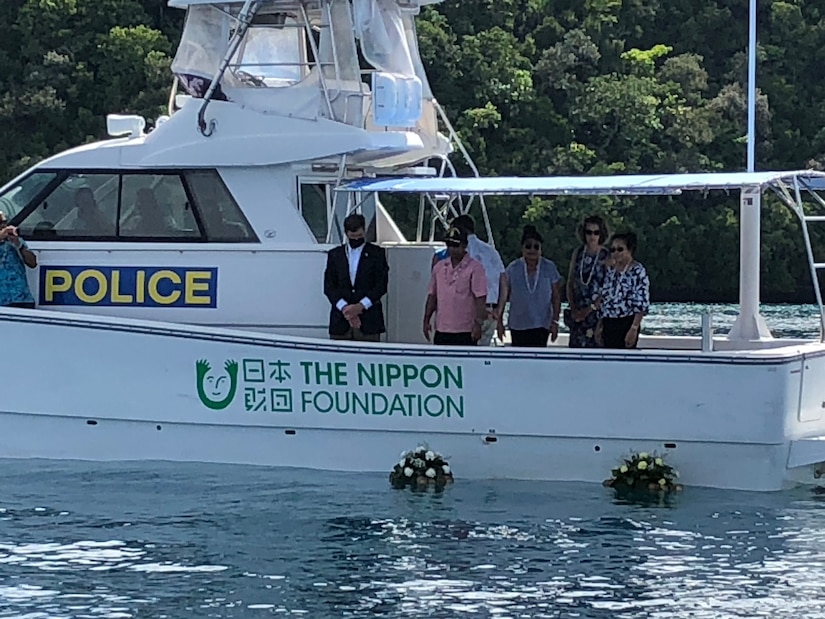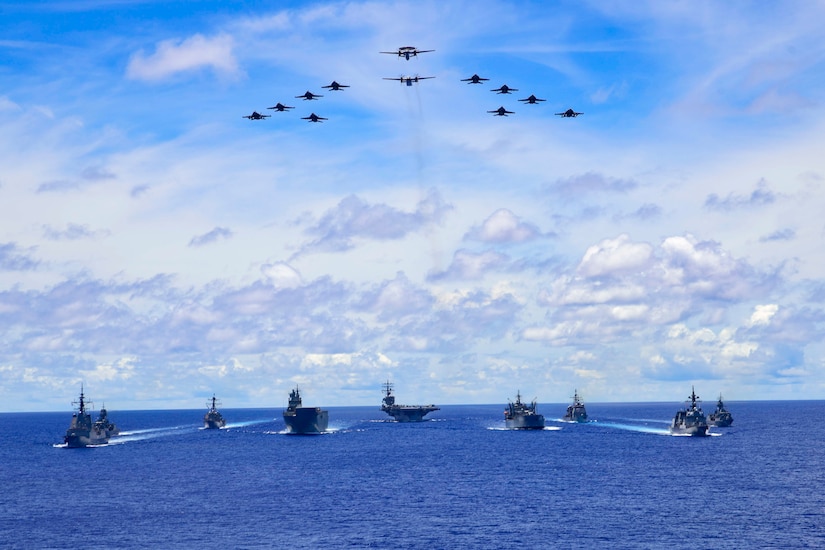Aug. 28, 2020 | , DOD News
The Pacific is full of American graves.
Defense Secretary Dr. Mark T. Esper and Palauan President Tommy Remengesau placed wreaths in the water above the sunken wreckage of a Navy TBM Avenger that crashed in the waters off the city of Koror, Palau, in 1944. All three of the bomber's crew members died.
Esper and Remengesau honored their sacrifice, and the sacrifices of thousands of Americans throughout the Pacific.

The TBM was lost in July 1944 as the United States was gearing up for the invasion of the neighboring island of Peleliu. Thousands of American Marines and soldiers lost their lives in that fight. The TBM crashed into the bay. It was flown by Navy Lt. Noland R. Houle, Petty Officer 3rd Class Walter E. Mintus and Chief Petty Officer Otis E. Ingram. The remains of Mintus and Ingram were recovered. Houle remains missing.
The area where the plane crashed is a jewel called the Rock Islands. It now draws divers from around the world to take in the stunning scenery and fabulous underwater world of Palau. The plane remains as an underwater memorial to them.
''The chance to have that moment with you, Mr. President, to honor them means a great deal to the United States,'' Esper said during a press conference with Remengesau. ''We are bound together by their sacrifice and many others who carry on this legacy today. And together, we remain committed to upholding the international rules and norms and promoting the free and open order that ensures security, stability, prosperity and sovereignty for nations of all sizes and all situations.''
The Palau TBM is just one grave of thousands. In Palau alone about 350 U.S. personnel from World War II remain unaccounted for, according to Navy officials.
Esper and the country will remember them on Sept. 2 when the nation commemorates the end of World War II aboard the USS Missouri, now docked in Pearl Harbor, Hawaii.
Just ahead of the Missouri – where the Japanese signed the unconditional surrender documents in 1945 – is the wreckage of the USS Arizona. It, too, is a grave for about a thousand sailors and Marines killed in Japan's surprise attack on Hawaii on Dec. 7, 1941.
Hundreds of thousands of Americans were killed in the Pacific during the war. Most were returned home. Others rest in the beautiful American Battle Monuments cemetery in Manila and in the Punchbowl Cemetery in Hawaii. But many died at sea, in the air, or on land and their bodies were not recovered.
The Battle of the Sunda Strait saw the loss of the cruisers USS Houston and HMAS Perth in February 1942 and more unmarked graves.
U.S. service members called the water around Guadalcanal ''Ironbottom Sound'' because so many ships were lost in the bloody 1942-43 battle for the island.
There are graves within the USS Yorktown, sunk during the Battle of Midway, which the U.S. won. There are more in the USS Lexington, which was lost during the Battle of the Coral Sea. There are more graves around the U.S. destroyers that served as picket ships in the Battle of Okinawa. Japanese kamikazes did most of that damage.
There are American graves in Bataan, the Philippines, New Guinea and on the various islands of the Philippines.

All of these American graves are evidence of the United States' commitment to the Indo-Pacific. There are strong ties created by values, friendship, trade and blood that bind the U.S. to the nations of the region.
''Palau, as you all know, is a close brother, friend and ally of the United States and is representative of the many, many friends of the United States here in the Pacific,'' Remengetau said during the press conference.
Now the area – like the rest of the Indo-Pacific – is battling COVID-19 and increasing Chinese pressure to change the international rules-based environment that has created an open and free Pacific.
''We continue to work alongside our allies and partners to protect the international system that is under threat from China, and its ongoing destabilizing activities in the region,'' Esper said.
The secretary met with Palauan officials and with Marines that are at the island nation aboard the USNS City of Bismarck. He also met with a Seabee civic action team that is deployed to the nation through March.






No comments:
Post a Comment